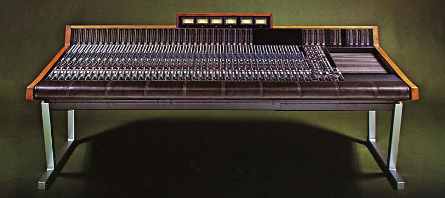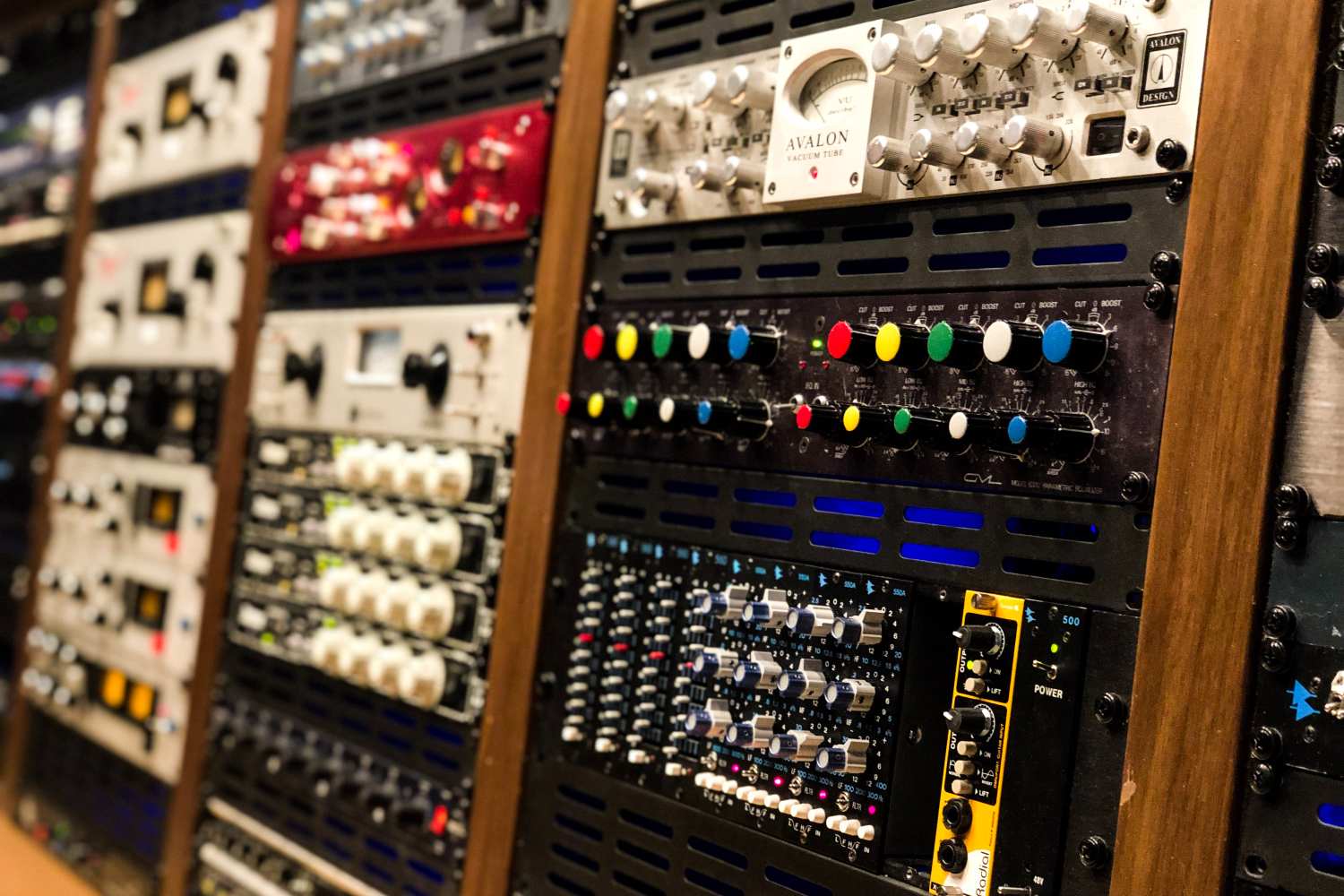A countdown for the ages.
The greatest hardware equalisers are tough to narrow down as the humble units are without doubt one of the most important and overworked weapons in an audio engineers’ arsenal. Just stop for a second and consider how many times we reach for it in an average session. Hundreds? Thousands maybe? Countless nano-second long parameter tweaks-notching out troublespots, reinforcing important harmonics, subtly bringing out detail where it was previously obfuscated. The A/B comparisons, gain matching, and bypassing.
Read all the latest features, columns and more here.
They are some of the most personal and interactive pieces of equipment in the entire recording chain and while they might not attract the same sort of coveted or transcendent associations that outboard compressors have formed over the years, hardware equalisers certainly do hold a particularly special place within the upper echelons of the audio community.
Varying from broadband, musicality to razor sharp sonic scalpels, we’ll be charging through the hardware units that simply stand above the rest, their unique voicings having helped shape the sound of thousands of records we’ve all come to adore, along with some of the most awe-inspiring and innovative topographies in studio history. Each name mentioned hasn’t made its way here through fanfare alone but rather, the unquestionable quality and inspiration they invoke upon those lucky enough to lay hands on them.
Let us embark upon the great journey that is – Mixdown’s Ten Greatest Hardware Equalisers of All Time.
Harrison 32C
The year was 1975 and Dave Harrison had just introduced the 32-Series console to the world. Having initially worked for and instigated in-line console designs for MCI, Harrison, wanting to push his designs further, branched off to form his own console company – Harrison, which brought the world the first 32-bus console.
Famed for its particularly colourful and inimitable EQ design for its time, the 32C’s EQ section pre-dated the kind of fully parametric equalisers we take for granted today, but its proportional Q response was undoubtedly parametric in nature, serving as a precursor to the kind of limitless tweakability that would follow.
This meant smaller boosts responded in nice broad and musical strokes, but when dialled in more aggressively, the Q sharpened, making for more surgical cutting or narrower boosts if and when required. This, paired with its unmistakably silky top end, served as the secret sauce behind the signature, hit-making Harrison sound, in turn creating one of defining sounds of the late ’70s and ’80s.

Each of the four EQ bands are sweep-able, with crossover frequencies between each corresponding bands and a +/-10dB range. By default, the low and high bands are shelving types, but can be switched to become bell shapes like the two mid bands, and with such wide sweep-able bands allows for very musical sound curves and shaping of whatever source material is fed through them. The high and low pass filters complete the EQ section, again each boasting astoundingly broad frequency ranges.
The control that this allowed for was akin to pop nirvana, with notable artists like Michael Jackson (Thriller, Bad), Queen and Paul Simon (Graceland) all opting for the Harrison 32c console and its forward-thinking EQ section.
Trident A-Range
Birthed in the infamous Trident Studios, London, the original Trident A-Range consoles are steeped in rock ‘n’ roll history, having left a distinct sonic imprint on countless seminal records from both British and American artists throughout the 1970s and ’80s.
The facility itself, one of the most in-demand of the era, had long earned a reputation for being at the forefront of studio technology, and in 1971, newly appointed studio manager, Malcom Toft, was eager to stay on the cutting edge, commissioning a new 24-track track tape machine for the main room at Tridents St. Anne’s address.
This would require a new console and after being unable to find a manufacturer to meet their requirements, Toft and Barry Porter took it upon themselves to design and build a custom console for the studio, and thus – the Trident A-Range was born.
There were only 13 of the Trident A-range original consoles made initially, and with their unmistakable eggplant colour, these original 13 have developed an almost mythical status amongst studio boffins who salivate over their incredible harmonic character and inductor-based EQ design. The momentum has undoubtedly lived on, with both Trident and Toft still making consoles to this day.
While the A-range consoles were renowned for their gorgeous, rich sounding preamp section, with minimal distortion in the audio path as noted by Toft, the EQ section drew particular attention to its users, and where the vibe and “magic” of the console really was.

The EQ section immediately stands out with its linear faders controlling a +/-15dB range of the four EQ bands, each of which have four selectable frequencies, with the low and high bands being shelves, and the two mid bands being bell curves. The high and low pass filters each have three frequency options, but uniquely can be selected simultaneously, creating some incredibly unique filter shapes; something that the EQ section became famous for.
Each frequency in the EQ section was supposedly picked and tuned by ear by Toft, other Trident in-house engineers and notable producers and engineers from outside the studio, which was refined over the years. The distinct sound and unique design of the console acquired remarkable levels of attention in the professional recording community, with later A-Range models being famously found in studios such as Cherokee Studios, Los Angeles.
Notable artists to have recorded and/or mixed on an A-Range console include the likes of David Bowie, Queen, Elton John, Rod Stewart, Frank Sinatra, T-Rex, among countless others.
Maag Audio EQ4
Moving away from EQs of famed channel strips for a second, next in our list is the magical blue box, the Maag Audio EQ4. Albeit a more modern piece of 500 series outboard (also available as a 1RU stereo mastering unit, the EQ4M), the EQ4 does indeed have its own rich history, stemming from the eminent NTI EQ3 of the ’80s.
Designed by one of the world’s premier audio perfectionists, Cliff Maag, it’s fair to say the EQ4 isn’t exactly a “workhorse” EQ in the sense that it isn’t from the parametric, surgically precise deft-touch school of EQ, like some of the others on this list. What it does however, is offer something that no other hardware EQ really does, hence why it’s made its rightful home on this list.
At first glance, one might think this humble little blue box is a simple 500 series six-band equaliser. However, the five position Air Band (six if you include the off position) throws this initial impression right out the window, with the EQ4 providing unparalleled openness (and for lack of a better word ‘air’) to whatever is fed into it. It’s something that really does need to be heard to be believed.

Even with whopping amounts of gain thrown at it, things never seem to get harsh or brittle, but rather just silkier and more musical. What’s more, even the 20kHz and 40kHz frequency selections (despite the latter being a whole octave above the range of human hearing) continue to bring an angelic breathiness and unspoilt clarity to proceedings, in a way which no other EQ has seemed to fully nail. This all combines to make the Maag EQ4 perfect for providing a sense of space and silky front to back separation for lead vocals, without the need to reach for a volume fader or ambient reverb – absolutely ideal for the modern pop workflow.
The five lower fixed frequency bands have been carefully selected, with the 2.5kHz band being a shelf shape, and the 650Hz, 160Hz, 40Hz, and 10Hz (sub) bands being bells shapes. Each band offers +15dB of gain for boosting and -4.5dB for cutting, with the Air Band being boost only.
The EQ4, unlike many other equalisers also boasts very little in the way of phase shift, a painstakingly detailed part of its design, keeping source material (and its relative phase relationships) very much intact. It’s absolutely a musical, tone shaping monster, with its famed Air Band having become synonymous with countless hit songs from artists such as Madonna, Justin Timberlake, Celine Dion, Pink and many, many more. A staple among the pros.
Undertone Audio MPEQ1
Easily one of the most versatile hardware equalisers ever created. The Swiss army knife, or dare I suggest, the Distressor of outboard equalisers would have to be the Undertone Audio MPEQ1, which is the brainchild of producer, audio guru, and Undertone Audio founder, Eric Valentine. For those unfamiliar with his credits, a quick search of the interwebs will be quite illuminating.
Initially integrated into his own custom console before becoming available as a single rack unit channel strip (before sadly becoming discontinued), the MPEQ1 features the full equaliser section found in the console, as well as the custom mic preamp. While we could easily do a full article on just the mic pre alone, the EQ section is where things really fire up!
The unit’s full Class-A design and 20V rails ooze everything there is to love about the vintage sound and design, paired with unreasonable amounts of modern flexibility. For example, both the high and low pass filters have abnormally wide frequency ranges. “Ok, cool guy, not exactly anything new there”. Agreed, but, each filter has variable slopes starting off at a gentle 6dB/octave, the filters can become wildly steeper and such, introducing varying degrees of resonant peaks cornered at the frequency the filter is set at. This combined with equalisers bands themselves becomes infinitely powerful, almost like what you would see in the world of analog synthesis.
As for the four parametric bands, each band can more or less replicate the shapes of any famed vintage console. I think we can all fill in the gaps of the usual suspects here. This is achieved by the ridiculous level of control available on each band. Sure, there’s Q control (pfft, standard parametric stuff), but also variable shape control and the ability to switch between bell, cut and notch modes. Typically, each band allows for 15dB or boost or cut, but when dialling in certain shelf and Q combinations this range can be extended to as much as 30dB worth of boost or cut, or if in notch mode, more or less complete cancellation, aka -50dB of attenuation!
A happy accident of the MPEQ1, which has turned out to be one of the most interesting and lifesaving features of the EQ section comes to the fore when in notch mode. Each band has the ability to adjust the phase of just that certain frequency range from which a particular band is set to. This becomes superlatively useful on multi mic’d sources like a drumkit, being able to perform a whole host of complex audio tasks like bringing the low end of a snare drum mic back into phase alignment with the overheads, where a standard 180 phase flip just doesn’t cut the mustard. For a full appreciation of this incredibly unique feature an RTFM disclaimer has been inserted here. Enjoy!
This beast of an EQ can pretty much be heard on anything Eric had recorded or mixed from the mid 2000’s on. Check out that discography and hear for yourself.
GML 8200
The last in Part One of our Greatest Hardware Equalisers of All Time list is none other than the GML 8200.
Whilst these days we may consider ol’ parametric equalisers as mere cannon fodder, there was such a time in which even the most esteemed audio minds would scoff at the suggestion of variable Q or bandwidth. But in other circles of audio society, a young George Massenburg had other plans.
In a technical paper presented at the 42nd Audio Engineers Society convention in 1972, Massenburg introduced the audio industry to the words “parametric equalisation”, an absolute revelation, one that quite frankly flipped the world of audio on its proverbial head. Aside from glaringly obvious technological breakthroughs in his subsequent inventions, Massenburg also brought a philosophy to his designs and something which has carried right through to this, the GML 8200. Massenburg’s lifelong obsession with transparency in the Audio domain.

Unlike many high-end or professional equalisers of the time, and flying in the face of what so many self proclaimed “expects” might tell you, sometimes transformers aren’t always the best option for pure unadulterated audio. Sometimes, one doesn’t need unnecessary harmonics or saturation, but rather, as little interference and colouration as possible. It’s with this awareness that the GML 8200 is a completely Class A – transformerless design, with no interstage or coupling capacitors.
The GML 8200 is as every bit as surgically precise and meticulously transparent as one might expect of a design borne out of such a delightfully puritanical ethos. Providing pinpoint accuracy and bountifully broad Q ranges across the five bands, the GML 8200 is equipped to tackle an equalisation task, with the overlapping frequency bands ranging from an infrasonic 15Hz to an ultrasonic 26kHz.
The low and high bands can also be switched from a shelf to bell curve, with +/-15dB of boost or cut available on each band. One of the most impressive parts of these equalisers is the minimal amount of resonance it imparts, even on the most heavy handed of EQ tasks. This pays particular dividends when performing surgical cuts to problematic frequencies, in turn leaving the rest of the frequency spectrum untarnished and with minimal artefacts.
The GML 8200 can be found in countless studio outboard racks across the globe, with several finding their rightful home at Blackbird Studios in Nashville, where Massenburg’s meticulously designed ATMOS room resides.
Check out part two of our greatest equalisers here! Be sure to check out Mixdown’s Greatest Compressors of All Time.







